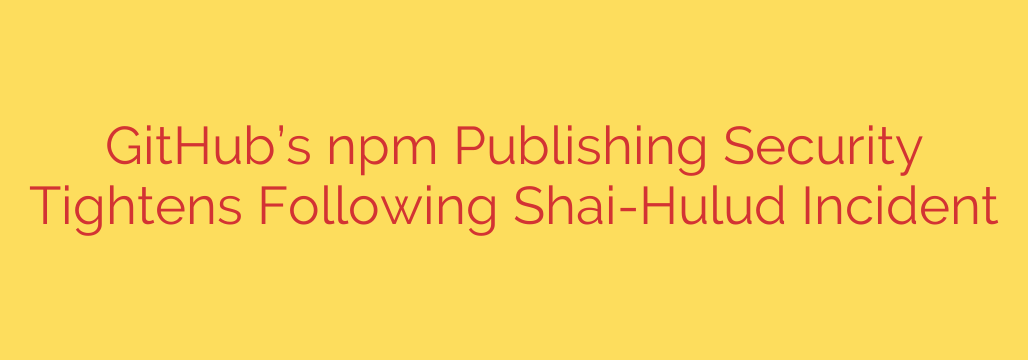
GitHub Overhauls npm Security: A Developer’s Guide to the New Publishing Rules
In a significant move to protect the integrity of the software ecosystem, GitHub is rolling out crucial security enhancements for the npm registry. These changes directly address the growing threat of software supply chain attacks, where malicious actors compromise developer accounts to publish corrupted packages. For developers and organizations relying on npm, understanding and adapting to these new measures is not just recommended—it’s essential for maintaining a secure development pipeline.
The modern development landscape is built on a foundation of open-source packages, but this interconnectedness creates vulnerabilities. Attacks like typosquatting, where malicious packages are given names deceptively similar to legitimate ones, and account takeovers pose a constant risk. These new security protocols are designed to create stronger defenses at the point of publication, safeguarding millions of downstream users.
Here’s a breakdown of the key changes and what you need to do to stay secure and compliant.
The End of Legacy Tokens: Introducing Granular Access
The most impactful change is the move away from broadly-scoped, legacy npm automation tokens. Previously, a single compromised token could grant an attacker extensive permissions, including the ability to publish new versions of any package owned by the user.
To combat this, GitHub has introduced new, granular access tokens. These tokens are a major leap forward for security, operating on the principle of least privilege.
- Package-Specific Scopes: You can now create tokens that are tied to specific packages or scopes (@owner/package). This means a token for
project-acannot be used to publish an update forproject-b. - Permission Levels: Tokens can be configured with either read-only or read-and-write permissions, preventing a token intended for CI checks from being used to publish a new version.
- Expiration Dates: All new fine-grained tokens must have an expiration date, a critical feature that limits the window of opportunity for attackers if a token is ever exposed.
This shift dramatically reduces the potential damage of a compromised CI/CD environment. Even if an attacker gains access to a token, its power is severely restricted to a specific package and a limited time frame.
Enhanced Security for CI/CD with GitHub Actions
For developers using GitHub Actions to automate their publishing workflows, the process is becoming even more secure and seamless. The setup-node action can now be configured to automatically generate a short-lived npm token for each workflow run.
This token is tightly integrated with the GitHub Actions identity, meaning it is only valid for that specific job and expires as soon as the job is complete. This ephemeral nature is a powerful defense, as there is no long-lived secret to be stolen from your repository’s settings.
Mandatory 2FA for Top Package Maintainers
Recognizing that popular packages are high-value targets, GitHub is also enforcing mandatory two-factor authentication (2FA) for maintainers of the most widely used npm packages. This measure adds a critical layer of security to user accounts, making it significantly harder for an attacker to gain control even if they manage to steal a password. While currently focused on top packages, this practice is a strong recommendation for all developers.
What You Need to Do Now: A Security Checklist
These changes require proactive steps from developers to ensure their publishing workflows continue to operate smoothly and securely.
Enable Two-Factor Authentication (2FA): If you haven’t already, secure your npm and GitHub accounts with 2FA immediately. This is one of the most effective security measures you can take to protect your packages and contributions.
Audit Your CI/CD Pipelines: Scour your automation scripts and repository secrets for legacy npm tokens (
NPM_TOKEN). Identify every place where these old, overly-permissive tokens are being used.Migrate to Granular Access Tokens: Begin replacing all legacy tokens with new, fine-grained access tokens. When creating them, follow the principle of least privilege:
- Assign the token to the specific package it needs to publish.
- Set the permission level to read-and-write only if necessary.
- Choose the shortest practical expiration date for the token.
Update Your GitHub Actions Workflows: If you use GitHub Actions, update your YAML files to leverage the built-in token generation. This involves granting the
contents: readandid-token: writepermissions to your publishing job to allow it to communicate securely with the npm registry.
By embracing these enhanced security measures, the developer community can collectively raise the bar against software supply chain attacks. While it requires an initial effort to update workflows and adopt new practices, the long-term benefits of a more resilient and trustworthy open-source ecosystem are invaluable.
Source: https://www.helpnetsecurity.com/2025/09/23/npm-publishing-security-improvements/








